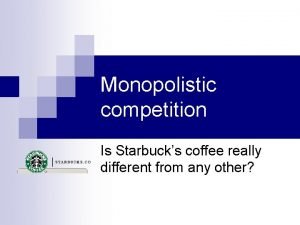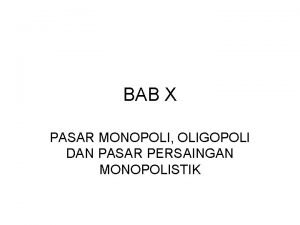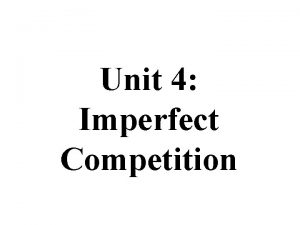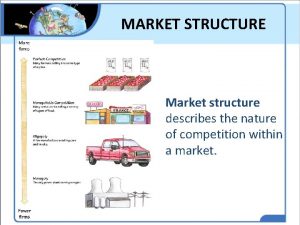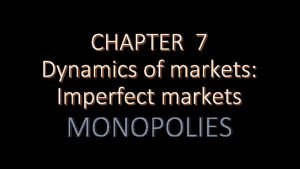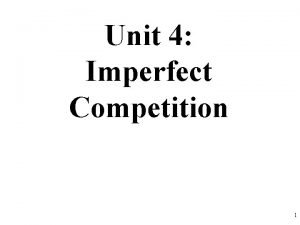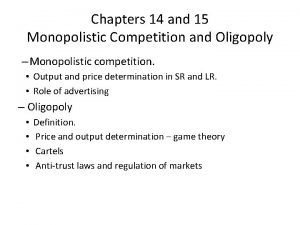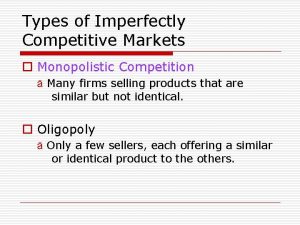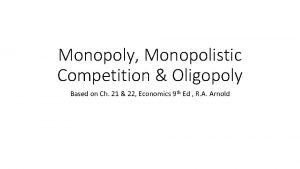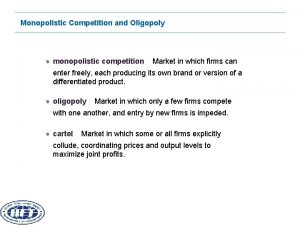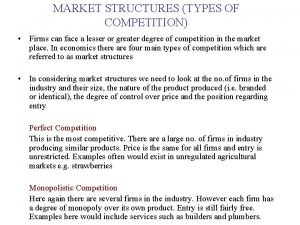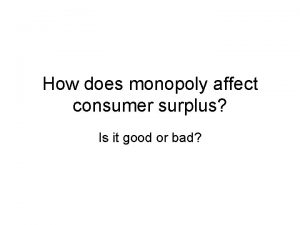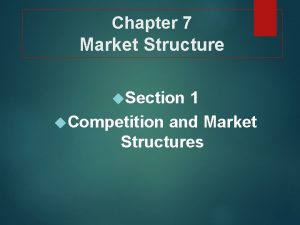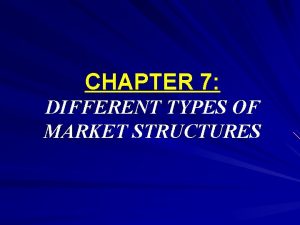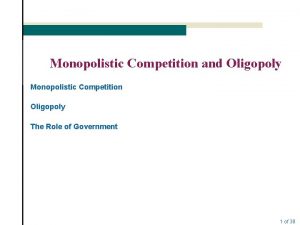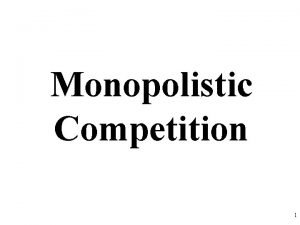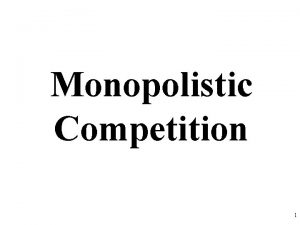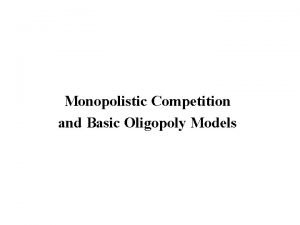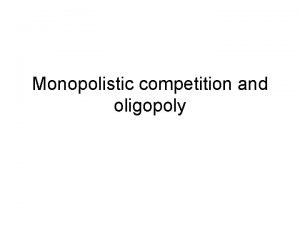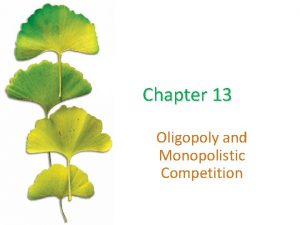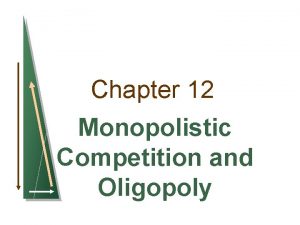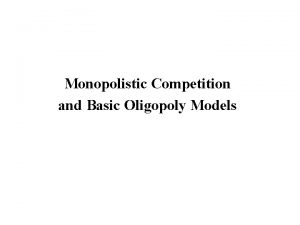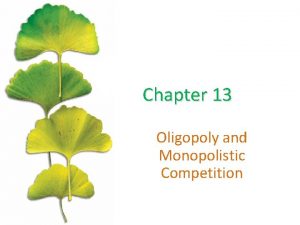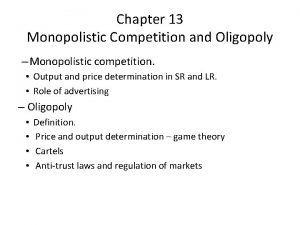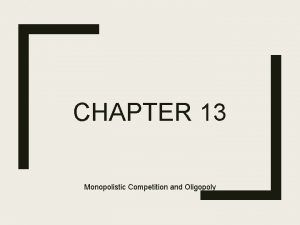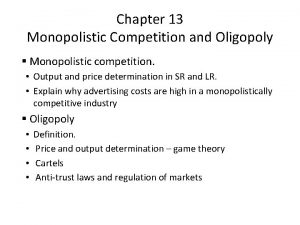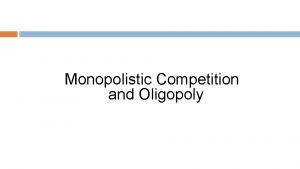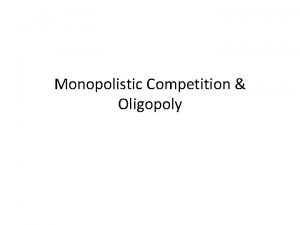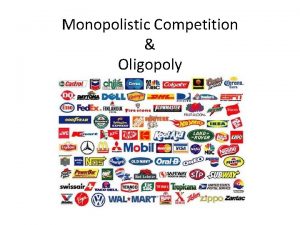Microeconomics 205 Monopoly Monopolistic Competition and Oligopoly Presented



























- Slides: 27

Microeconomics 205 Monopoly, Monopolistic Competition and Oligopoly Presented by Amanda Stiglbauer June 30, 2020 Amanda. Stiglbauer@moore. sc. edu

Econ. Ed. Link Membership You can now access CEE’s professional development webinars directly on Econ. Ed. Link. org! To receive these new professional development benefits, become an Econ. Ed. Link member. As a member, you will now be able to: • Automatically receive a professional development certificate via e-mail within 24 hours after viewing any webinar for a minimum of 45 minutes • Register for upcoming webinars with a simple one-click process • Easily download presentations, lesson plan materials, and activities for each webinar • Search and view all webinars at your convenience • Save webinars to your Econ. Ed. Link dashboard for easy access to the event You may access our new Professional Development page here

Professional Development Certificate To earn your professional development certificate for this webinar, you must: • Watch a minimum of 45 -minutes and you will automatically receive a professional development certificate via e-mail within 24 hours. Accessing resources: • You can now easily download presentations, lesson plan materials, and activities for each webinar from Econ. Ed. Link. org/professionaldevelopment/

Agenda • Market Structure Simulation (Virtual Version) • Market Structures Matching Pairs • Collaboration – Monopoly • Monopoly Mini-Lesson • Monopolistic Competition & Activities • Oligopoly Intro, Games and Clips

Objectives • I can differentiate the characteristics of imperfectly competitive market structures. • I can describe activities to help teach monopoly, oligopoly and monopolistic competition.

National Standards • Standard 9: Competition and Market Structure Competition among sellers usually lowers costs and prices, and encourages producers to produce what consumers are willing and able to buy. Competition among buyers increases prices and allocates goods and services to those people who are willing and able to pay the most for them.

Monopoly

Pure Monopolies • Single Seller • No close substitutes • “Price Maker” • Blocked Entry Examples: – – – – – De Beers diamonds Professional sports teams Utilities Cable Taxis* lottery Patents on prescriptions Small, isolated communities Natural monopolies – downward sloping ATC (economies of scale)

RIP MR. DARP October 30 - Today

Monopolist’s MR<D • Because monopolist must set a lower price to obtain greater sales, marginal revenue is less than price for every level of output except the first. – Lower price applies to all units sold. – Think about it this way: MR decreases for all units sold previously because you must charge same price for all.



Graphing Monopoly

Ways to Deal With Monopolies – Do Nothing – Break Up Using Anti. Trust Regulation – Publically own – Price Regulation • Price ceiling • Socially optimal price/fair return price

Price Discriminating Monopolists • A monopolist who charges different prices to different buyers. • Why would a monopolist do this? To increase profit! • Legal examples: – – – Airlines Movie theaters Cell phone companies Golf courses Hotels Textbook companies

Additional Resources for Monopoly • Monopoly Overview – MR University • Price Discrimination – MR University • Monopoly and Imperfect Competition – Crash Course • AP Micro – Monopoly Lesson Plan - Econ. Ed. Link

Monopolistic Competition


Monopolistic Competition Like Monopoly - Downward sloping demand marginal revenue - Some control over price Like Perfect Competition - Normal profits in the long run - Easy entry and exit - Large number of sellers Unique - Non price competition and advertising - Differentiated products


Long Run Equilibrium

Activities to Introduce Oligopoly • Play Tic-Tac-Toe with a partner • Play Connect 4

Oligopoly

Characteristic In Oligopolies…. # of Firms Few large producers Products Homogenous or differentiated Barriers to Entry Yes--significant Economies of scale (requires large capital expenditures to enter) Profit Potential (SR and LR) Yes -supernormal profits possible in SR and LR Price Setting Power Price maker BUT must consider possible reaction of rivals (interdependence) Non-price competition Some use advertising Efficiency No! Examples Airlines, Banks, Cigarettes, Beer, Household appliances, Breakfast Cereal

Oligopoly • Interdependent behavior – profits depend on others • Businesses are best off when they collude (make an agreement about price/quantity) • Cartel: group of firms acting in unison to produce a monopoly outcome • Game theory: Study of how people act in strategic situations. “Do unto others BEFORE they do to you” • Prisoner’s Dilemma: Game between two prisoners that illustrates why cooperation is difficult to maintain, even when mutually beneficial. • Dominant Strategy: best for a player, no matter what the other does BUT STILL MUST CONSIDER WHAT OTHER PLAYER IS DOING TO DETERMINE YOUR DOMINANT STRATEGY

Oligopoly Resources • Econ. Movies – The Dark Knight • Golden Balls • Oligopoly and Game Theory – Crash Course

CEE Affiliates https: //www. councilforeconed. org/resources/local-affiliates/
 Chapter 7 section 3 monopolistic competition and oligopoly
Chapter 7 section 3 monopolistic competition and oligopoly Difference between perfect competition and monopoly market
Difference between perfect competition and monopoly market Is starbucks a perfect competition?
Is starbucks a perfect competition? Characteristics of an oligopoly
Characteristics of an oligopoly Difference between monopoly and monopolistic competition
Difference between monopoly and monopolistic competition Difference between monopoly and monopolistic competition
Difference between monopoly and monopolistic competition Monopoly vs monopolistic competition
Monopoly vs monopolistic competition Lump sum subsidy monopoly
Lump sum subsidy monopoly Pure competition vs monopolistic competition venn diagram
Pure competition vs monopolistic competition venn diagram Perfect competition vs monopolistic competition
Perfect competition vs monopolistic competition Oligopoly vs monopoly
Oligopoly vs monopoly Monopoly vs oligopoly venn diagram
Monopoly vs oligopoly venn diagram Market structure describes
Market structure describes Difference between perfect competition and monopoly
Difference between perfect competition and monopoly Characteristics of monopoly
Characteristics of monopoly Hhi monopolistic competition
Hhi monopolistic competition Non price competition in oligopoly
Non price competition in oligopoly Free entry and exit
Free entry and exit Monopolistic competition characteristics
Monopolistic competition characteristics Super normal profit meaning
Super normal profit meaning Consumer surplus in monopolistic competition
Consumer surplus in monopolistic competition Monopolistic competition price
Monopolistic competition price Oligopoly characteristics
Oligopoly characteristics Monopolistic competition in long run
Monopolistic competition in long run Monopolistic competition short run
Monopolistic competition short run How does monopoly affect consumer surplus
How does monopoly affect consumer surplus Monopolistic competition examples
Monopolistic competition examples Monopolistic competition examples
Monopolistic competition examples


